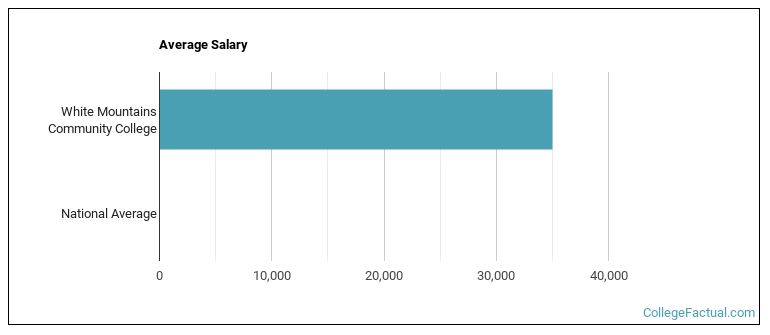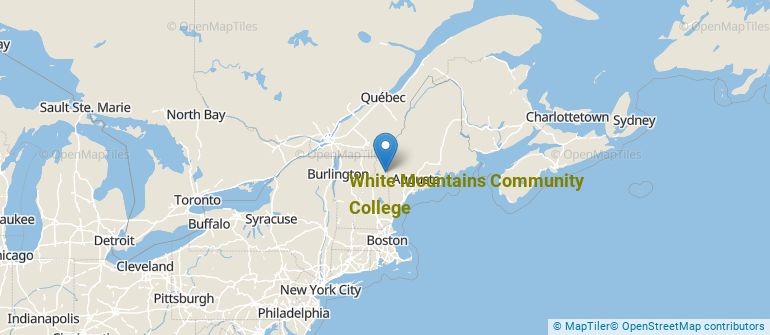 by our College Data Analytics Team
by our College Data Analytics TeamExplore the best ranked schools for the programs you are most interested in.
Out of the 17 colleges in New Hampshire, White Mountains Community College is ranked at #16.
White Mountains Community College was not ranked in College Factual's Best Overall Colleges report this year. This may be because not enough data was available.
See all of the rankings for White Mountains Community College.
If you are worried about getting into White Mountains Community College, don't be. The school has a liberal open admissions policy, which means you only need to meet basic requirements in order to be admitted. Still, be sure to submit a complete application and provide any other requested materials.
The student to faculty ratio at White Mountains Community College is an impressive 7 to 1. That's quite good when you compare it to the national average of 15 to 1. This is a good sign that students at the school will have more opportunities for one-on-one interactions with their professors.
Another measure that is often used to estimate how much access students will have to their professors is how many faculty members are full-time. The idea here is that part-time faculty tend to spend less time on campus, so they may not be as available to students as full-timers.
The full-time faculty percentage at White Mountains Community College is 28%. This is lower than the national average of 47%.
White Mountains Community College has a freshmen retention rate of 76%. That's a good sign that full-time students like the school and their professors enough to want to stick around for another year. It's also a sign that the admissions team did a good job in choosing applicants who were a good fit for the school.
During the 2017-2018 academic year, there were 649 undergraduates at White Mountains Community College with 211 being full-time and 438 being part-time.
| $0-30 K | $30K-48K | $48-75 | $75-110K | $110K + |
|---|---|---|---|---|
| $14,937 | $18,767 | $18,767 | $18,767 | $18,767 |
The net price is calculated by adding tuition, room, board and other costs and subtracting financial aid.Note that the net price is typically less than the published for a school. For more information on the sticker price of White Mountains Community College, see our tuition and fees and room and board pages.
It's not uncommon for college students to take out loans to pay for school. In fact, almost 66% of students nationwide depend at least partially on loans. At White Mountains Community College, approximately 49% of students took out student loans averaging $5,777 a year. That adds up to $23,108 over four years for those students.
Get more details about paying for White Mountains Community College.

See which majors at White Mountains Community College make the most money.
Get more details about the location of White Mountains Community College.

Contact details for White Mountains Community College are given below.
| Contact Details | |
|---|---|
| Address: | 2020 Riverside Drive, Berlin, NH 03570 |
| Phone: | 603-752-1113 |
| Website: | www.wmcc.edu/ |
| Most Popular Majors | Bachelor’s Degrees | Average Salary of Graduates |
|---|---|---|
| Precision Metal Working | 39 | NA |
| Nursing | 24 | NA |
| Vehicle Maintenance & Repair | 15 | NA |
| Allied Health & Medical Assisting Services | 13 | NA |
| Culinary Arts | 12 | NA |
| Ground Transportation | 12 | NA |
| Special Education | 11 | NA |
| General Education | 9 | NA |
| Heavy/Industrial Equipment Maintenance | 8 | NA |
| Teacher Education Grade Specific | 7 | NA |
Online learning is becoming popular at even the oldest colleges and universities in the United States. Not only are online classes great for returning adults with busy schedules, they are also frequented by a growing number of traditional students.
In 2022-2023, 266 students took at least one online class at White Mountains Community College. This is a decrease from the 339 students who took online classes the previous year.
| Year | Took at Least One Online Class | Took All Classes Online |
|---|---|---|
| 2022-2023 | 266 | 120 |
| 2021-2022 | 339 | 152 |
| 2020-2021 | 395 | 148 |
| 2018-2019 | 290 | 110 |
Learn more about online learning at White Mountains Community College.
Footnotes
*The racial-ethnic minorities count is calculated by taking the total number of students and subtracting white students, international students, and students whose race/ethnicity was unknown. This number is then divided by the total number of students at the school to obtain the racial-ethnic minorities percentage.
References
More about our data sources and methodologies.